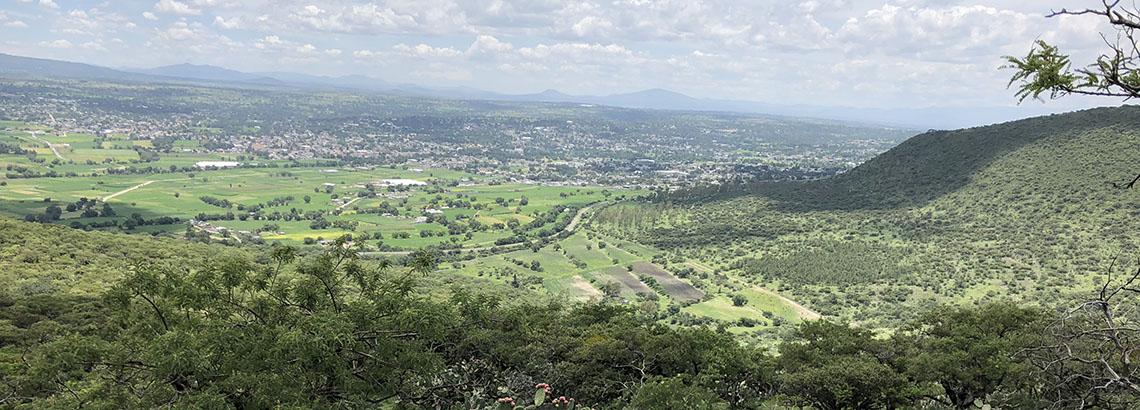
Politics and History of Sustainability: The Northern Basin of Mexico Historical Ecology Project
We are studying the roles of political and climate change on humans and landscapes across long periods of history. This research is of fundamental importance in work on sustainability for several reasons. It documents how local people adapted to or did not adapt to changing politics, including the rise and decline of states and empires, colonialism and the modern nation-state.
The project helps shed light on how local people adapted to or did not adapt to both natural and human-induced environmental changes, such as drought, erosion and deforestation. It also provides important case studies on the social dimensions of environmental change and persistence. It connects ancient cases to contemporary issues and environmental crises. And it explores the important connections between archaeological and cultural heritage to ecological conservation.
Project Details
The Historical Ecology Project of the Northern Basin of Mexico is specifically studying the dual role of political and climatological change on human settlements and landscapes across long periods of stability and transformation in the Northern Basin of Mexico.
With several years of support from the National Science Foundation, National Geographic Society, Wenner Gren, and Digital Globe, this research has focused broadly on how changes in the macro-regional political economy and environmental changes have influenced and continue to influence local ecological, social and economic relationships and decisions. Major periods of time include:
- The Classic period (ca. 0-650 CE) when the powerful state Teotihuacan exerted influence over the area
- The Epiclassic period (ca. 650-900) after Teotihuacan collapsed and a fragmented, unstable political landscape formed
- The Early Postclassic period (ca. 900-1200) when much of the area was integrated into a new regional state system centered at Tula
- The Middle Postclassic period (ca. 1200-1350) after Tula collapsed and a new landscape of roughly independent city-states emerged
- The Late Postclassic period (ca. 1350-1519) a period of time that witnessed the rise in power of some key city-states, which would eventually lead to the formation of the Aztec empire (ca. 1428)
- The Early Colonial period (ca. 1519-1620) a period after the Spanish moved into the area, toppled the Aztec state, and conquered surrounding towns. This was a period of dramatic population decline and resettlement
- The Late Colonial period (ca. 1620-1830), a period of changing economic investments and developments in rural economies that fostered new institutions of inequality
Targeting such complexity requires considerable investment and extensive efforts to reconstruct both top-down and bottom-up processes. It requires research that is:
- Regional in scope and multi-sited
- Intensively local, focusing on communities and households.
The project area covers over 200 square kilometers in several municipalities in Mexico.
We are resurveying and mapping many sites documented almost 40 years ago. We are combining this work with a systematic program of test excavations as well as intensive horizontal excavations in a range of different sites, such as small hamlets, villages and centers.
This work is integrated with a program of paleo-ecological investigations as well as geomorphological excavations in a series of areas with evidence of human impact, such as ancient canals and terraces.
This project integrates several lines of data and analysis:
- Analysis of the spatial and temporal organization of archaeological sites via intensive mapping and excavation
- Aerial photography
- VHR Satellite data (i.e., Quickbird and GeoEye)
- Geological and chemical soil characterization
- Paleobotanical and paleoethnobotanical data (macrobotanical, phytoliths, pollen and starch)
- Zooarchaeological data
- Artifact data, including chemical characterization of pottery and lithics
- Analysis of diatoms, ostracodes, calcareous algae and micro-mollusks
- Bioarchaeological data
In terms of the size of the project area, the investment in both regional and local investigation, as well as the multiple methodologies employed, this research represents one of the largest archaeological projects to be undertaken in the Basin of Mexico in decades.
The project is also an international collaboration, involving researchers and students from both the United States and Mexico.
As part of a larger project on the long-term historical ecology of the northern Basin of Mexico, this is engaged research. Project contributors work closely with community members, organizations, museums and, importantly, local initiatives, such as community-directed ecological protection and reforestation projects.
This project offers exceptional opportunities for ASU students to undertake research for theses and PhD dissertations and to collaborate internationally. Interested students and prospective graduate students are encouraged to contact Christopher Morehart and consider a graduate career at ASU studying the complex historical ecology of Mexico.
Partner: Institute of Anthropological Investigations, National and Autonomous University of Mexico
Research Team
- Christopher T. Morehart, Arizona State University, principal investigator
- Abigail Meza Peñaloza, National and Autonomous University of Mexico, bioarchaeologist
- Charles Frederick, University of Texas at Austin, geoarchaeologist
- Angela Huster, Arizona State University, ceramicist
- Destiny Crider, Luther College, ceramicist
- John Millhauser, North Carolina State University, geochemistry
- Lorenzo Vázquez Selem, National and Autonomous University of Mexico, dendrochronology
- Manuel Palacios, Terra Nostra Earth Sciences, paleoecology
- Antonio Lorenzini, Project management
Funding
National Science Foundation
National Geographic Society
Wenner Gren Foundation
Digital Globe Foundation